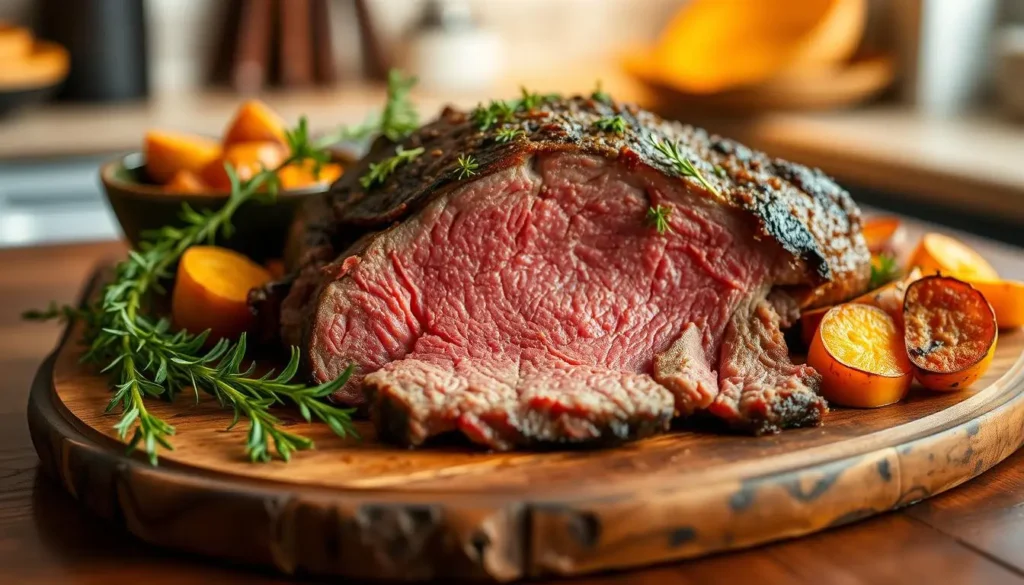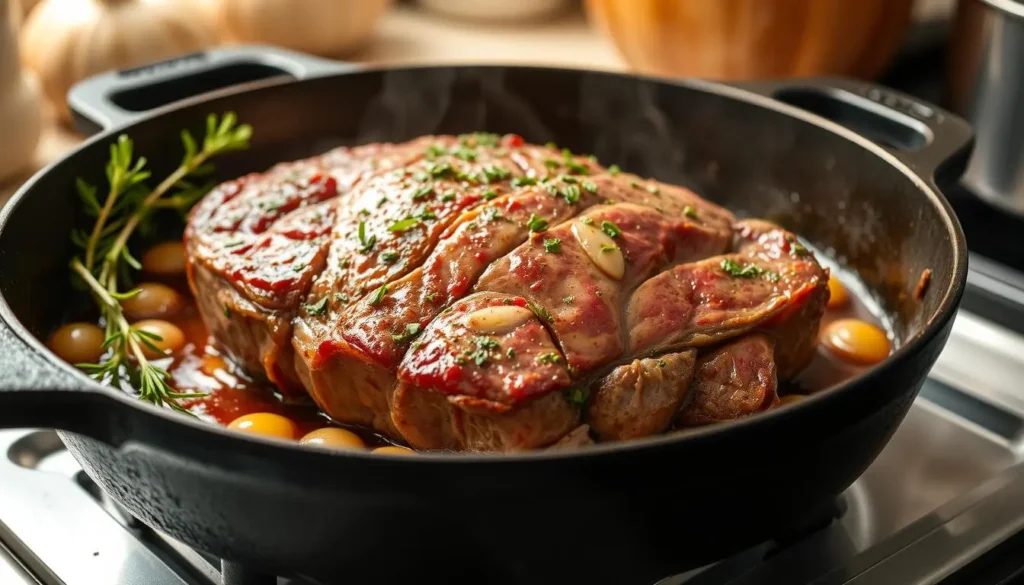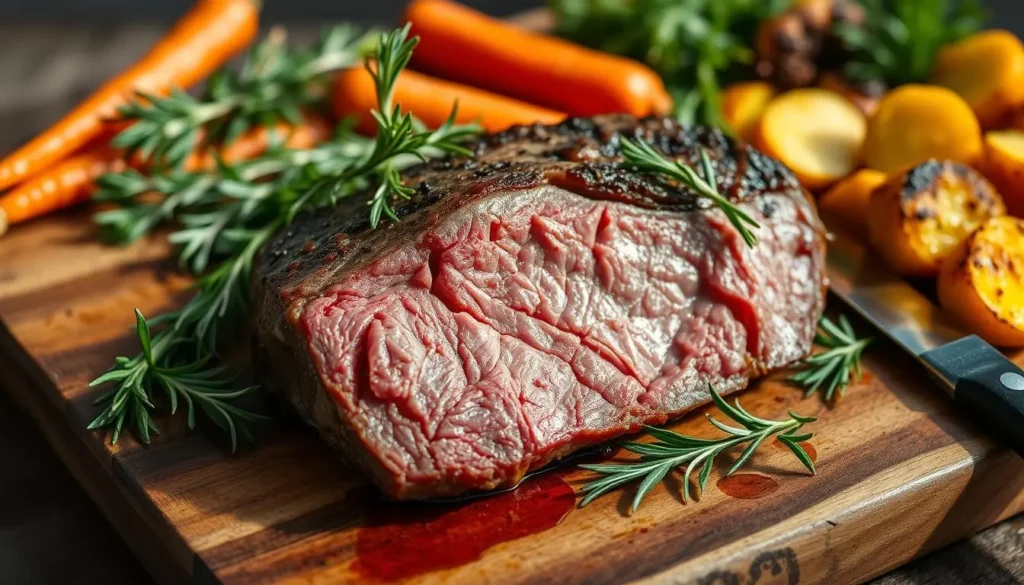Ever wondered what a bottom round roast is good for? It’s all about knowing the different names for this cut of meat. You might see various names at your local butcher or in recipes. This can make cooking confusing, so it’s key to know the alternative names for bottom round roast.
Exploring bottom round roast, you’ll find it’s great for many dishes, like stews and roasts. Before cooking, it’s important to understand the different names and their meanings. This helps you follow recipes and cooking tips better, ensuring your roast is always perfect. Whether you’re searching for a new recipe or just curious, this article will guide you.
Key Takeaways
- Understanding alternative names for bottom round roast is essential for cooking and recipe navigation.
- Bottom round roast is a versatile cut of meat that can be used in various dishes.
- Knowing the different names for bottom round roast can help you choose the right cut of meat for your recipe.
- A bottom round roast recipe can be used to create a delicious and tender roast.
- What is a bottom round roast good for? It’s perfect for hearty stews, tender roasts, and other savory dishes.
- Exploring the different names and uses for bottom round roast can help you expand your culinary skills and repertoire.
- With the right knowledge and recipe, you can create a mouth-watering bottom round roast that’s sure to impress.

What is Another Name for Bottom Round Roast?
Ever wondered does a bottom round roast get more tender the longer you cook it? The answer is tied to how you cook it. In the U.S., this cut of meat is known by different names. These names can change how you cook it and how tender it becomes.
Names like outside round roast and western griller are common. They vary by region and influence cooking methods. For instance, outside round roast is slow-cooked to tenderize it. Western griller, on the other hand, is cooked quickly for a crispy exterior.
Regional American Names
In the U.S., bottom round roast has many names. Here are a few:
- Outside round roast: Common in the Northeast and Midwest.
- Western griller: Popular in the West.
- Bottom round roast: Used everywhere.
Knowing these names helps you does a bottom round roast get more tender the longer you cook it. It lets you tailor your cooking to make it tender and tasty.
In summary, the name for bottom round roast affects its cooking and tenderness. By understanding these names, you can fine-tune your cooking. This way, you’ll get the best results.
| Name | Region | Cooking Method |
|---|---|---|
| Outside round roast | Northeast and Midwest | Low and slow |
| Western griller | Western states | High temperature |
| Bottom round roast | Nationwide | Varies |
Understanding the Location and Characteristics of Bottom Round
When cooking a tasty bottom round roast recipe, knowing the cut is key. The bottom round roast is from the cow’s hindquarters, near the rump. It’s leaner meat, which can be tricky to cook but yields tender and flavorful results.
Let’s look at the bottom round roast’s main features:
- Lean meat with less marbling, making it ideal for those looking for a leaner bottom round roast recipe
- Tougher texture due to its location on the cow, requiring proper cooking techniques to achieve tenderness
- Smaller size compared to other roast cuts, making it perfect for smaller gatherings or family meals
Knowing about the bottom round roast helps you make a delicious bottom round roast recipe. It impresses everyone, whether you’re an expert or new to cooking. Learning about this meat is worth it.
| Characteristics | Description |
|---|---|
| Location | Hindquarters of the cow, near the rump |
| Meat Type | Lean meat with less marbling |
| Texture | Tougher due to its location on the cow |
| Size | Smaller compared to other roast cuts |
Now you’re closer to making a delicious bottom round roast recipe. It will become a favorite in your home.
Distinguishing Features of Bottom Round Roast
Understanding what a bottom round roast is good for starts with its features. Its texture and grain pattern are key to its quality and use. This cut is great for slow-cooking because of its coarse texture and grain.
The fat and marbling in the bottom round roast are also important. It has less fat, making it a lean choice. But the marbling adds moisture and flavor, enhancing its taste in many dishes.
Key Characteristics
- Coarse texture
- Prominent grain pattern
- Low fat content
- Marbling for moisture and flavor
Knowing these traits helps you see how to best use a bottom round roast. It’s perfect for hearty stews or tender roasts, impressing everyone.
By focusing on the bottom round roast’s unique features, you can make amazing meals. These dishes will delight even the pickiest eaters.
| Feature | Description |
|---|---|
| Texture | Coarse |
| Grain Pattern | Prominent |
| Fat Content | Low |
| Marbling | Present |
Best Cooking Methods for Bottom Round Roast

There are many ways to cook a tasty bottom round roast. You can choose oven roasting, slow cooking, or grilling. Each method has its own benefits, depending on what you like and how tender you want the roast to be. It’s important to know the right temperature and cooking time for the best results.
Oven roasting is great for a tender and juicy roast. Season the roast with your favorite herbs and spices. Then, put it in a roasting pan and cook it in a preheated oven. Slow cooking is also a good option, especially on busy days when you want a meal ready when you get home.
Some popular cooking methods for bottom round roast include:
- Oven roasting: perfect for a tender and juicy roast
- Slow cooking: great for a busy day when you want to come home to a ready-to-eat meal
- Grilling: ideal for a crispy crust and a smoky flavor
No matter the method, make sure to cook the roast to the right internal temperature. This ensures it’s safe to eat. Use a meat thermometer to check the temperature and prevent overcooking.
By following these tips, you can make a delicious bottom round roast recipe. It’s perfect for impressing your family and friends. Whether you’re experienced or new to cooking, you can try different methods and seasonings to find your favorite.
Temperature and Timing Guidelines
When cooking a bottom round roast, knowing the right temperature and timing is key. You might ask, does a bottom round roast get more tender the longer you cook it? Yes, but only until a certain point. Cooking it too long can make it tough and dry.
To get a tender and juicy roast, it’s important to cook it to the right internal temperature. For a bottom round roast, aim for at least 135°F (57°C) for medium-rare, 145°F (63°C) for medium, and 160°F (71°C) for medium-well or well-done.
Ideal Cooking Duration
The cooking time is key to a tender bottom round roast. A 3-4 pound roast takes 20-25 minutes per pound at 325°F. But, it can vary with your oven and the roast’s size.
Resting Period Importance
After cooking, let the roast rest for 10-15 minutes before slicing. This lets the juices spread, making it tender and flavorful. Following these steps will give you a deliciously tender roast that impresses everyone.
Comparing Bottom Round to Other Beef Cuts
Choosing the right beef cut can be tricky. You might wonder is top round or bottom round better? Both have unique qualities. Let’s compare bottom round to top round, eye of round, and rump roast.
Bottom round is lean and tender, perfect for roasting or grilling. Top round is slightly more tender with a milder taste, great for sandwiches or salads. Eye of round is lean but can be tough if not cooked right. Rump roast has more fat, giving it a richer flavor.
Here’s a quick comparison of these cuts:
- Bottom Round: lean, tender, and perfect for roasting or grilling
- Top Round: slightly more tender, milder flavor, and great for sandwiches or salads
- Eye of Round: lean, can be tough if not cooked properly, and ideal for slow cooking
- Rump Roast: richer flavor, higher fat content, and perfect for special occasions
When deciding between top round and bottom round, it’s about personal preference. Bottom round offers a leaner cut with bold flavor. Top round is better for those who prefer a milder taste and tender texture.
Flavor Profile and Seasoning Recommendations
Bottom round roast has a rich, beefy taste with a hint of sweetness. The right seasonings are crucial to enhance this flavor. A good bottom round roast recipe will use herbs and spices that complement the beef’s taste.
Some popular seasonings for bottom round roast include:
- Garlic and thyme
- Rosemary and lemon
- Paprika and black pepper
These combinations can make a tasty and aromatic bottom round roast recipe that will wow your guests.
By using these seasonings and quality ingredients, you can make a delicious bottom round roast recipe. It’s perfect for any event or a simple weeknight dinner. A well-seasoned bottom round roast is always a crowd-pleaser.
Common Uses in Different Cuisines
Exploring the uses of bottom round roast in various cuisines is key. It’s great for a wide range of dishes, from American comfort food to international recipes. This beef cut adds flavor and texture to any meal.
In American cooking, bottom round roast is a staple in hearty stews and braises. It’s slow-cooked to tender perfection. You’ll also find it in deli-style sandwiches, thinly sliced with your favorite toppings.
International Preparations
Internationally, bottom round roast shines in dishes like Carne Asada in Mexican cuisine. It’s grilled to perfection and served with fresh salsa and warm tortillas. In Asian cooking, it’s quickly cooked in stir-fries and noodle dishes with vegetables and savory sauces.
Deli-Style Applications
In deli-style, bottom round roast is a hit in cold cuts and sandwiches. It’s also found in salads and wraps with fresh veggies and tangy dressings. It’s perfect for a quick snack or a filling meal.
Some favorite dishes with bottom round roast include:
- Roast beef sandwiches
- Beef stroganoff
- Carne Asada tacos
- Beef and broccoli stir-fry
Bottom round roast is a versatile ingredient. It brings rich flavor and tender texture to many dishes. So, what is a bottom round roast good for? It’s great for adding flavor and excitement to any meal.

Conclusion: Making the Most of Your Bottom Round Roast
The bottom round roast is a versatile and budget-friendly cut of beef. It can be turned into a delicious meal. Whether you’re using a bottom round roast recipe or trying different cooking methods, knowing its characteristics is key.
This roast may not be as tender as others. But the longer you cook it, the more tender it will become. Follow the recommended temperature and timing, and use the right seasoning. This will bring out its full flavor and texture.
With its affordable price and versatility, the bottom round roast is a smart choice. It’s great for budget-conscious home cooks. So, don’t be afraid to experiment and make the most of this overlooked gem in your kitchen.
FAQ
What is another name for bottom round roast?
Bottom round roast is also known as outside round roast or western griller. In some places, it’s called chuck roast or bottom sirloin roast.
Does a bottom round roast get more tender the longer you cook it?
Yes, cooking a bottom round roast for a longer time makes it tenderer. The longer it cooks, the more the tough fibers break down. This makes the meat softer and easier to chew.
Is top round or bottom round better?
Both top round and bottom round are good cuts of beef. Top round is tender and juicy, while bottom round is cheaper but less tender. Your choice depends on what you like and how you plan to cook it.
What is a bottom round roast good for?
Bottom round roast is great for many dishes. It’s perfect for slow-cooked roasts, braised dishes, and stews. It’s also good for making deli-style roast beef. With the right cooking, it’s both tasty and affordable.
What is the best way to cook a bottom round roast?
You can cook a bottom round roast in several ways. Oven roasting, slow cooking, and grilling are all good options. The key is to use a method that tenderizes the meat, like marinating or cooking at a low temperature for a long time.
What is the ideal internal temperature for a bottom round roast?
The best internal temperature for a bottom round roast is 135°F for medium-rare or 145°F for medium. Always let the roast rest for 15-20 minutes before slicing. This lets the juices spread, making the meat tender and flavorful.

